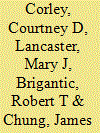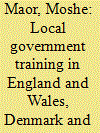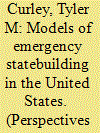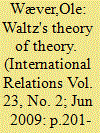|
|
|
Sort Order |
|
|
|
Items / Page
|
|
|
|
|
|
|
| Srl | Item |
| 1 |
ID:
126220


|
|
|
|
|
| Publication |
2012.
|
| Summary/Abstract |
This research follows the Updated Guidelines for Evaluating Public Health Surveillance Systems, Recommendations from the Guidelines Working Group, published by the Centers for Disease Control and Prevention nearly a decade ago. Since then, models have been developed and complex systems have evolved with a breadth of disparate data to detect or forecast chemical, biological, and radiological events that have a significant impact on the One Health landscape. How the attributes identified in 2001 relate to the new range of event-based biosurveillance technologies is unclear. This article frames the continuum of event-based biosurveillance systems (that fuse media reports from the internet), models (ie, computational that forecast disease occurrence), and constructs (ie, descriptive analytical reports) through an operational lens (ie, aspects and attributes associated with operational considerations in the development, testing, and validation of the event-based biosurveillance methods and models and their use in an operational environment). A workshop was held in 2010 to scientifically identify, develop, and vet a set of attributes for event-based biosurveillance. Subject matter experts were invited from 7 federal government agencies and 6 different academic institutions pursuing research in biosurveillance event detection. We describe 8 attribute families for the characterization of event-based biosurveillance: event, readiness, operational aspects, geographic coverage, population coverage, input data, output, and cost. Ultimately, the analyses provide a framework from which the broad scope, complexity, and relevant issues germane to event-based biosurveillance useful in an operational environment can be characterized.
|
|
|
|
|
|
|
|
|
|
|
|
|
|
|
|
| 2 |
ID:
093007


|
|
|
| 3 |
ID:
193041


|
|
|
|
|
| Summary/Abstract |
This article investigated the intra-urban distribution of child hawking in Enugu Municipality, Nigeria. The study first enumerated child hawkers across three residential areas (core, transition and sub-urban) simultaneously on different weekdays and at different locations (activity-nuclei) in Enugu municipality. A questionnaire was then employed to obtain information from 95 incidentally selected child hawkers, comprising 49, 21 and 25, respectively. Information sourced was their socio-economic characteristics and factors influencing their taking to the street to hawk. The data were analysed using percentages, cross tabulation and standard scores. Results showed that 58.9% were males, 53.7% were out-of-school and 47.4% realized ₦501.00–₦1000.00 ($1.4USD–$2.78USD) per day. Factors influencing child hawking, measured through an index tagged ‘Child Hawkers’ Factor Index’ (CHFI) on a 5-point Likert-type scale, showed that poverty was the most prevalent factor in the core, transition and sub-urban areas of the municipality, respectively, with (CHFI = 3.67), (CHFI = 3.64) and (CHFI = 3.37). The study further showed that there was a relationship between child hawking incidence and land use activities. It observed that the core residential area, junction, Motor Park and market land uses were generators of child hawkers. The study suggested effective urban planning and policy measures in addressing the menace of child hawking.
|
|
|
|
|
|
|
|
|
|
|
|
|
|
|
|
| 4 |
ID:
096940


|
|
|
|
|
| Publication |
2010.
|
| Summary/Abstract |
This article highlights an interesting and often unduly neglected aspect of comparative public policy and administration: local government training. The argument advanced is that local government training based on the centrally focused model may tend to be: (i) skill-oriented and competence-framed; (ii) comprehensive; and (iii) quality-controlled in a relatively rigorous manner. By contrast, local government training based on the locally focused model may tend to be: (i) skill-oriented and competence-framed alongside a focus on 'people' and organizational issues, conventional policy issues and broad local government issues; (ii) non-comprehensive, and (iii) weakly controlled for quality. The integrative model, which is the most innovative form of the three models presented here, may tend to manifest a varied mix of the aforementioned features. Based on an institutional analysis combined with interviews with senior training officials at national and local levels, this argument is illustrated in England and Wales, Denmark and Israel in the hope that it could be a starting point for developing hypotheses and propositions.
|
|
|
|
|
|
|
|
|
|
|
|
|
|
|
|
| 5 |
ID:
141310


|
|
|
|
|
| Summary/Abstract |
Over the last decade, the impact of emergencies on the American state has become the subject of renewed interest. While early literature in the post-9/11 era often overlooked the historical development of crisis governance in the United States, many scholars have begun to uncover the precedents that continue to shape modern emergency management. In an effort to clarify the main analytical assumptions of the existing scholarship, I construct three models of emergency statebuilding: permanent emergency state, national security state, and contract state. The models each share an underlying framework of historical institutionalism, which defines the state as a stabilized material institutional structure that is disrupted by emergency conditions—exogenous shocks that cannot be incorporated into the normal statebuilding processes or legal order. Yet this perspective is ill-equipped to explain institutional change. I propose discursive institutionalism as an approach that emphasizes how discourse and ideas construct emergencies as objects of government management—in different ways, at different times. I then illustrate the utility of this perspective by demonstrating the influence of national planning ideas on efforts to prepare the state for emergencies before they occur.
|
|
|
|
|
|
|
|
|
|
|
|
|
|
|
|
| 6 |
ID:
152164


|
|
|
|
|
| Summary/Abstract |
In order to face the challenge of sustainable urban development on its own territory, China has chosen Singapore as its model and privileged partner. By analysing more than 20 years of cooperation, the aim of this article is to study what sort of vision and model for development China is pursuing, how the “Singaporean model” is imported and incorporated by Chinese stakeholders, and in what ways it is transforming the specificities in planning, building, and organising the country’s cities. Our analysis covers two Sino-Singaporean urban operations that are currently leading the way in China: the Suzhou Industrial Park and the Tianjin eco-city. The incorporation of the Singaporean model into these two operations shows that the latter offers an effective way of linking economic development with urban production, and of enabling the building of orderly cities with good environmental standards. However, these advances have only been made possible by the capacity to take political and financial initiatives that are still exceptional in the country as a whole, and until now do not appear to be easily extendable to other Chinese cities. Moreover, the Sino-Singaporean view of urban development based on productivity and concentrating on supply, infrastructure, and technology encounters major limitations in terms of environmental sobriety and the cities’ social integration.
|
|
|
|
|
|
|
|
|
|
|
|
|
|
|
|
| 7 |
ID:
087386


|
|
|
|
|
| Publication |
2009.
|
| Summary/Abstract |
Terrorist organizations change over time because of processes such as recruitment and training as well as counter terrorism measures, but the effects of these processes have mostly been studied qualitatively and reductively. Seeking a more quantitative and integrated understanding, the author constructed a simple dynamic model where equations describe how these processes change an organization's membership. Analysis of the model yields a number of intuitive as well as novel findings. Most importantly, it becomes possible to predict whether counter terrorism measures would be sufficient to defeat the organization. Furthermore, the author can prove in general that an organization would collapse if its strength and its pool of foot soldiers decline simultaneously. In contrast, a simultaneous decline in its strength and its pool of leaders is often insufficient and short-termed. These results and others like them demonstrate the great potential of dynamic models for informing terrorism scholarship and counter terrorism policy making.
|
|
|
|
|
|
|
|
|
|
|
|
|
|
|
|
| 8 |
ID:
090144


|
|
|
|
|
| Publication |
2009.
|
| Summary/Abstract |
Waltz's 1979 book, Theory of International Politics, is the most influential in the history of the discipline. It worked its effects to a large extent through raising the bar for what counted as theoretical work, in effect reshaping not only realism but rivals like liberalism and reflectivism. Yet, ironically, there has been little attention paid to Waltz's very explicit and original arguments about the nature of theory. This article explores and explicates Waltz's theory of theory. Central attention is paid to his definition of theory as `a picture, mentally formed' and to the radical anti-empiricism and anti-positivism of his position. Followers and critics alike have treated Waltzian neorealism as if it was at bottom a formal proposition about cause-effect relations. The extreme case of Waltz being so victorious in the discipline, and yet being so consistently misinterpreted on the question of theory, shows the power of a dominant philosophy of science in US IR, and thus the challenge facing any ambitious theorising. The article suggests a possible movement of fronts away from the `fourth debate' between rationalism and reflectivism towards one of theory against empiricism. To help this new agenda, the article introduces a key literature from the philosophy of science about the structure of theory, and particularly about the way even natural science uses theory very differently from the way IR's mainstream thinks it does - and much more like the way Waltz wants his theory to be used.
|
|
|
|
|
|
|
|
|
|
|
|
|
|
|
|
|
|
|
|
|